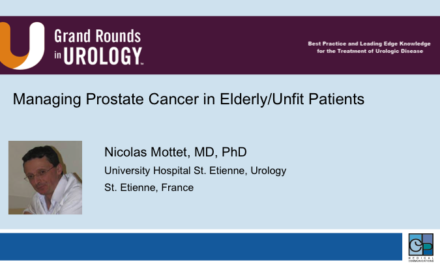Timothy N. Showalter, MD, MPH, presented “Long-Term Outcomes with Monotherapy for LR and fIR Prostate Cancer” as part of a course on Prostate Brachytherapy released in 2021 and created by the American Brachytherapy Society in partnership with Grand Rounds in Urology.
How to cite: Showalter, Timothy N. “Long-Term Outcomes with Monotherapy for LR and fIR Prostate Cancer.” September 2021. Accessed Nov 2025. https://grandroundsinurology.com/long-term-outcomes-with-monotherapy-for-lr-and-fir-prostate-cancer/
Long-Term Outcomes with Monotherapy for LR and fIR Prostate Cancer
As part of a special course on brachytherapy for prostate cancer from the American Brachytherapy Society (ABS) and Grand Rounds in Urology, Timothy N. Showalter, MD, MPH, Associate Professor of Radiation Oncology at the University of Virginia in Charlottesville, discusses long-term outcomes of and recent advances in brachytherapy monotherapy for low-risk (LR), favorable intermediate-risk (fIR), and selected unfavorable intermediate-risk (uIR) prostate cancer. He begins by listing potential advantages of brachytherapy monotherapy, highlighting that it features a single episode of care, is cost-effective, is multidisciplinary, has excellent long-term outcomes, features established technology to support tailored dosimetry and quality, and has been the subject of recent advances that enhance implant quality and reduce toxicity. Dr. Showalter then considers patient selection for brachytherapy monotherapy, noting that MRI may be useful in selecting patients with LR, fIR, and selected uIR disease. He emphasizes the importance of assessing whether a patient’s anatomy is suitable for implant based on gland size and arch interference, as well as the need to determine whether a patient has adequate baseline urinary function. Dr. Showalter also lists contraindications to brachytherapy monotherapy, including relative contraindications such as a large TURP defect, a large gland, and a large median lobe, as well as absolute contraindications such as inability to tolerate anesthesia, unacceptable operative risk, and the absence of a rectum. He then moves on to consider long-term outcomes of brachytherapy monotherapy, noting that for LR, fIR and selected uIR, follow-up data indicates biochemical progression-free survival of greater than 90%. Dr. Showalter also observes that outcomes are favorable in terms of toxicity, although there are some declines in urinary and sexual function. Finally, Dr. Showalter briefly summarizes recent advances in brachytherapy, emphasizing the role of advanced imaging such as MRI in helping to tailor brachytherapy dose and increase the personalization of care.
For more on brachytherapy, check out the first module of the free Prostate Brachytherapy course from GRU and the American Brachytherapy Society.
ABOUT THE AUTHOR
Timothy N. Showalter, MD, MPH, MBA, is the Chief Medical Officer at AteraAI, a precision medicine company that develops AI-enabled tests. Dr. Showalter also serves as a Professor of Radiation Oncology at the University of Virginia in Charlottesville. His clinical interests include genitourinary and gynecologic cancers, and advanced external beam radiation therapy techniques.





